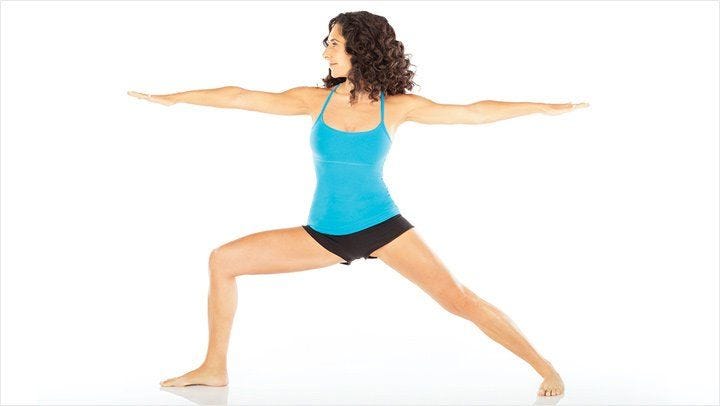Utkatasana and Virabhadrasana – Yoga Warrior Sequence
Grounding and Lightness: Flowing Out of the Standing Sequence with Utkatasana and Virabhadrasana
One of the beautiful things about practicing Ashtanga Yoga is that there are no beginnings or endings – only transitions. In the Primary Series, one of the more marked transitions comes as a dynamic series of postures often called the “Warrior Sequence.” Moving through the powerful postures Utkatasana, Virabhadrasana A, and Virabhadrasana B, this sequence carries the practitioner from the standing sequence to the ground, ready to begin the “seated sequence” of the Primary Series. As these postures all call upon the combination of a strong, grounded lower body and a buoyant, upward-reaching torso, they offer a valuable opportunity to explore the interweaving of apanic and pranic patterns intrinsic to the physical practice of Ashtanga Yoga.
Entering Utkatasana
This section of the series begins by revisiting the Surya Namaskara. After completing Ardha Baddha Padmotanasana, return to Samasthitihi, or “even standing.” Moving through the vinyasas of Surya Namaskara A, jump directly from Adho Mukha Svanasana (Downward Facing Dog) into Utkatasana. This is the same position as the first vinyasa of Surya Namaskara B; with knees bent and chest lifted, raise the arms with palms together and gaze at your thumbs.
Holding the five breaths of Utkatasana can be a formidable experience. Even its name speaks to its dynamic nature – translations for “utkata” include wild, terrifying, intense, powerful, fierce, and, perhaps most straightforwardly, difficult. It can be helpful to use the five breaths here to deepen an awareness of the energetic patterns running through this posture. The exhale welcomes attention paid towards downward energy, sinking deeper into the legs and feeling the strengthening curl of the pelvis and lower abdominals as the breath empties. Inhaling, experience the scooping upward of the abdominals in uddiyana bandha, the chest lifting as it fills with air. As you key in more and more deeply to these powerful energetic patterns, it becomes easy to see how “intense” and “fierce” this posture can truly be, beyond the surface physical difficulties of its prolonged performance.
Entering Virabadhrasana A

After completing Utkatasana, fold forward and move again through the motions of Surya Namaskara. From Adho Mukha Svanasana, bring the right foot between the hands, sealing the turned-out left foot to the ground and bending deep into the right knee. Inhale to rise, raising the arms as in the seventh and eleventh vinyasas of Surya Namaskara B. This is Virabhadrasana A. After five breaths here, exhale to pivot to the back of the room, sinking into the left knee to perform the same posture on the opposite side. From here, inhaling, move into Virabhadrasana B, opening the body to the side of the mat and extending the arms parallel with the ground, gaze reaching over the front fingertips. Again after five breaths, switch sides, exhaling to pivot to the front of the mat and sink deeply into the right knee.
Virabhadrasana, often referred to as Warrior Yoga Pose, actually translates to Virabhadra’s pose, named in tribute to a powerful warrior from the Hindu belief. When the daughter of king Daksha fell in love and married the god Shiva, her father was not pleased. To express his feelings on the union, Daksha threw a party, inviting everyone except Lord Shiva – and so infuriating his daughter that she either burst into flames or threw herself into a fire, depending on who’s telling the story. Shattered at the death of his beloved, Shiva threw one of his dreadlocks down to earth and Virabhadra was born. The warrior god, an agent of righteous vengeance, cut off Daksha’s head, leaving a trail of destruction in his wake.
Virabadhrasana B

It is for this force that the final yoga posture of the standing series is named. It’s a telling choice, for performing this posture is no small feat. It encompasses a series of opposing forces, working together to create an energetically dynamic experience. Energy shoots backward through the strongly extended back leg, while at the same time being sent forward through the bend in the front knee. There is a slight external rotation in the front leg, while the back leg cultivates the opposite, working into an internal rotation. On top of it all, the opposing forces of the apanic and pranic patterns are readily accessible in this pose, grounding downwards on the exhale and finding lift and buoyancy on the inhale.
With all of this happening at once, Virabhadrasana becomes a powerful yoga asana in cultivating the opposite, doing two opposing actions simultaneously, finding the apanic in the pranic and vice versa. There are many ways to interpret the naming of this yoga posture, but perhaps the simplest is in noticing the ways it allows us to uncover the forces of nature accessible within us. After all, practicing it with integrity calls upon deep inner power physically, energetically, and mentally, cultivating a strength that can feel like it comes from both beyond and within ourselves – much in the vein of the story of Virabhadra. Coming to the floor with this awareness, we carry with us s power source we can tap into and a greater consciousness to employ.



